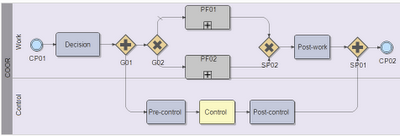<discussion ref="
http://www.linkedin.com/groupAnswers?viewQuestionAndAnswers=&gid=1062077&discussionID=4933019&commentID=4950034&goback=.anh_1062077#commentID_4950034" />
Very interesting discussion about “dimensions”. Try to contribute from the architecture side.
I think that any enterprise BPM system (see
http://improving-bpm-systems.blogspot.com/2009/04/should-we-consider-third-forgotten-bpm.html for its definition) is a complex and dynamic set of interconnected and interdependent artefacts. For BPM the most important types of business artefact are:
- events
- processes
- activities
- rules
- roles
- objects(data and documents)
- audit trails
- key performance indicators (KPIs)
- services
The evolution of some artefacts and the relationships between them is necessary to accommodate typical changes in enterprise policies, enterprise priorities, compliance, technology, laws, etc. So, to be agile and responsive in business, it must be easy to modify all artefacts and their relationships without causing any negative effects (e.g. unexpected delays and undesired consequences) in any part of the BPM system.
I think that the four main architectural principles are necessary to achieve a high level of flexibility:
1. All artefacts must be versionable throughout their lifecycle.
2. All artefacts must evolve to become digital, externalised, virtual and components of clouds.
3. All relationships between artefacts must be modelled explicitly.
4. All models must be made to be executable.
More relationships are explicit and executable –> more knowledge about functioning of the enterprise -> more predictable results -> more rational decisions -> more comprehensive optimisation.
The best example of explicit and executable relationships between business artefacts is process -- who (role) is doing what (objects and activities), when (coordination of activities), why (rules), how (activities) and with which results (KPIs).
I think this approach follows the discussion, especially the previous post from Michael.
Thanks,
AS





